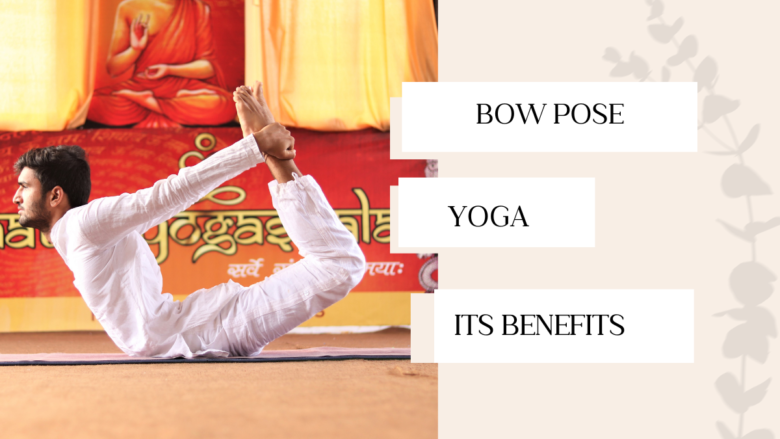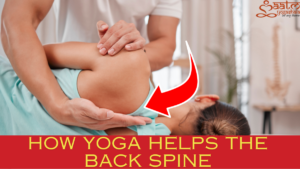Introduction to Bow Pose Yoga
Welcome to AatmYogashala Blog,Bow Pose Yoga , known as Dhanurasana in Sanskrit, is a foundational yoga posture that dates back centuries. This pose is revered for its ability to open the chest and stretch the entire front body, making it a staple in many yoga practices. Today, Bow Pose yoga is celebrated not only for its physical benefits but also for its role in enhancing mental clarity and emotional balance.
What is Bow Pose Yoga?
Bow Pose Yoga, known as Dhanurasana in Sanskrit, is a powerful back-bending asana that resembles the shape of a drawn bow. Derived from the words “Dhanu” meaning bow and “Asana” meaning pose, this posture is a fundamental element in many yoga sequences due to its comprehensive benefits.
In performing Bow Pose, the practitioner lies on their stomach, bends their knees, brings their feet towards their head, and reaches back with their hands to grasp the ankles. This action creates a graceful arc in the body, symbolizing the taut string of a bow.
By engaging both the upper and lower parts of the body, Bow Pose builds strength, improves flexibility, and enhances coordination and balance.
It is particularly effective in opening the chest and shoulders, stretching the entire front body, and strengthening the back muscles. Despite its challenges, with mindful practice and proper technique, Bow Pose can be accessible and beneficial for yogis at all levels.
Top 10 Benefits of Dhanurasana (Bow Pose Yoga)
- Improves Flexibility
Dhanurasana stretches the entire front body, including the chest, abdomen, quadriceps, and hip flexors, enhancing overall flexibility.
- Strengthens Back Muscles
Engaging and contracting the back muscles during Bow Pose Yoga helps to build strength and improve posture.
- Stimulates Digestive Organs
The compression and stretch of the abdominal region can stimulate the digestive organs, aiding in better digestion and relieving constipation.
- Opens the Chest
The deep chest opening experienced in Bow Pose Yoga can improve respiratory function and increase lung capacity.
- Relieves Back Pain
By strengthening the back muscles and improving spine alignment, Dhanurasana can help alleviate chronic back pain.
- Boosts Circulation
The pose promotes better blood circulation, particularly in the spinal and abdominal areas, supporting overall physical health.
- Reduces Stress and Anxiety
The combination of chest opening and controlled breathing in Bow Pose Yoga can effectively reduce stress levels and alleviate anxiety.
- Enhances Focus and Concentration
Maintaining the balance and alignment required in Bow Pose Yoga helps improve mental clarity and focus.
- Improves Posture
Strengthening the muscles along the spine and opening the chest can contribute to better posture and alignment.
- Balances Emotions
The deep stretching and release of tension during Dhanurasana can help release trapped emotions and promote emotional stability and balance.
Step-by-Step Guide to Perform Bow Pose Yoga
Preparation
Before attempting Bow Pose Yoga, ensure your body is warmed up with some light stretching or a few rounds of Sun Salutations.
Instructions
- Start on Your Stomach
Lie face down on your yoga mat with your arms by your sides and palms facing up.
- Bend Your Knees
Slowly bend your knees, bringing your heels as close to your buttocks as possible.
- Grab Your Ankles
Reach back with your hands and grasp your ankles. Ensure your grip is firm but gentle.
- Lift Your Chest and Thighs
Inhale deeply. As you exhale, lift your chest and thighs off the mat simultaneously, keeping your gaze forward.
- Hold the Pose
Maintain the position for 20-30 seconds, breathing steadily. Feel the stretch along your front body and the contraction in your back muscles.
- Release
Exhale and slowly lower your chest and thighs back to the mat. Release your ankles and return to the starting position.
Tips for Beginners
Warm-Up Exercises
- Cat-Cow Stretch
Loosen up your spine with a few rounds of Cat-Cow Stretch.
- Cobra Pose
Prepare your back muscles by practicing Cobra Pose before attempting Bow Pose Yoga.
Modifications
- Use a Strap
If you find it difficult to reach your ankles, use a yoga strap looped around your feet to help you get into the pose.
- Support Your Chest
Place a folded blanket under your chest for added support and comfort.
Common Mistakes to Avoid
- Overarching the Lower Back
Focus on lifting your chest and thighs equally to avoid straining your lower back.
- Holding Your Breath
Maintain steady, deep breaths throughout the pose to maximize its benefits.
What is Bow Pose Yoga good for?
Bow Pose Yoga is a highly beneficial posture with numerous advantages for both physical and mental well-being. Physically, it enhances flexibility, especially in the chest, abdomen, and hip flexors. It strengthens back muscles, improving posture and alleviating back pain.
The pose also stimulates the digestive organs, promoting better digestion and easing issues like constipation.
Beyond physical benefits, Bow Pose Yoga significantly impacts mental and emotional health. It reduces stress and anxiety through deep, controlled breathing and chest opening. The concentration needed to maintain the pose enhances mental clarity and focus, making it valuable for mindfulness.
Emotionally, mastering the pose boosts self-confidence and provides a sense of achievement. The stretch and release of tension in the body promote emotional balance, helping to release pent-up emotions and fostering overall well-being.
Bow Pose Yoga for Beginners
For beginners, Bow Pose Yoga can initially seem challenging, but with mindful preparation and patience, it can be a rewarding addition to your yoga practice. Here are some tips and modifications to help you ease into the posture and reap its benefits:
Gradual Approach
Start Slowly
Rather than trying to immediately lift your chest and thighs high off the mat, focus on small, controlled movements. Begin by practicing the preparatory steps and gradually increasing your range of motion.
Warm-Up Exercises
Gentle Stretching
Incorporate gentle stretching routines such as the Cat-Cow Stretch and Child’s Pose to warm up your muscles and increase flexibility. These stretches can prepare your body for the more intense movements required in Bow Pose Yoga.
Modifications
Use Props
Utilizing props like yoga straps or blocks can significantly assist beginners. Loop a strap around your ankles if you’re unable to reach them comfortably. This allows you to experience the essence of Bow Pose without overstraining.
Supported Bow Pose Yoga
Place a rolled blanket or bolster under your chest to provide extra support. This modification helps you maintain the pose with less effort, enabling you to focus on proper alignment and breathing.
Alignment Tips
Focus on Alignment
Ensure that your knees remain hip-width apart and avoid allowing them to splay outward. Equal lifting of your chest and thighs will help distribute the stretch evenly across your body.
Breathe Mindfully
Deep, steady breathing is essential in Bow Pose. Concentrate on breathing into your chest to facilitate a deeper stretch and bring relaxation to the posture.
Consistent Practice
Regular Practice
Incorporate Bow Pose into your regular yoga routine. Consistent practice will enhance your flexibility and strength over time, making the pose more accessible and comfortable.
By easing into Bow Pose with these beginner-friendly tips, you can progressively build the strength and flexibility needed to fully enjoy this beneficial yoga posture.
What is the Bow Pose Good For?
Bow Pose is an incredibly beneficial yoga posture with numerous advantages for both physical and mental well-being. Physically, it enhances flexibility in the chest, abdomen, and hip flexors. It strengthens back muscles, improving posture and alleviating back pain.
The pose also stimulates digestive organs, promoting better digestion and easing constipation.
Beyond physical benefits, Bow Pose impacts mental and emotional health. It reduces stress and anxiety through deep breathing and chest opening.
The concentration needed to maintain the pose can improve mental clarity and focus, adding value to mindfulness practice.
Emotionally, mastering the pose can boost self-confidence and a sense of accomplishment. The stretch and release of tension help promote emotional balance and overall well-being.
Why is Bow Pose So Difficult?
Bow Pose, or Dhanurasana, can be challenging due to its engagement of multiple muscle groups and the flexibility required. The deep backbend demands strength and mobility in the spine and surrounding muscles.
Tight hip flexors, quadriceps, or a stiff lower back can make achieving the full arc difficult. Additionally, the chest must open fully, and the shoulders must be flexible enough to grasp the ankles comfortably.
Another challenging aspect is the coordination and balance required. Lifting the chest and thighs off the mat simultaneously involves a balance between strength and flexibility, demanding both back muscle engagement and abdominal control.
Breath control is crucial, as holding the breath can create unnecessary tension. For many beginners, these combined elements make Bow Pose demanding and intense, requiring patience and consistent practice to master.
Faqs for Bow Pose Yoga
Is Bow Pose safe for beginners?
Yes, Bow Pose is safe for beginners when practiced with proper alignment and modifications. Always listen to your body and avoid pushing yourself too hard.
How often should I practice Bow Pose?
Incorporate Bow Pose into your routine 2-3 times a week. Consistency is key to reaping its benefits.
Can Bow Pose help with back pain?
Bow Pose can help strengthen the back muscles and improve posture, potentially alleviating mild back pain. However, consult with a healthcare professional before practicing if you have severe back issues.
Can I practice Bow Pose during pregnancy?
It is generally advised to avoid Bow Pose during pregnancy, especially in the later stages, due to the pressure it places on the abdomen. Pregnant individuals should always consult with their healthcare provider before attempting any yoga poses.
What should I do if I feel discomfort in my knees?
If you experience discomfort in your knees while practicing Bow Pose, it might be helpful to cushion them with a folded blanket or yoga mat. Alternatively, you can try modifications, such as using a strap to assist in reaching your ankles or adjusting the intensity of the pose to suit your comfort level.
Conclusion
Mastering the bow pose can significantly enhance your yoga practice, offering a myriad of physical, mental, and emotional benefits. By incorporating this pose into your routine, you can improve flexibility, build back strength, and foster a sense of mental clarity and emotional balance. Always remember to approach the pose with mindful preparation, correct technique, and modifications as needed to ensure a safe and effective practice. Whether you are a beginner or a seasoned yogi, the strides made in perfecting Bow Pose can translate to overall well-being and a deeper connection to your body and mind.




